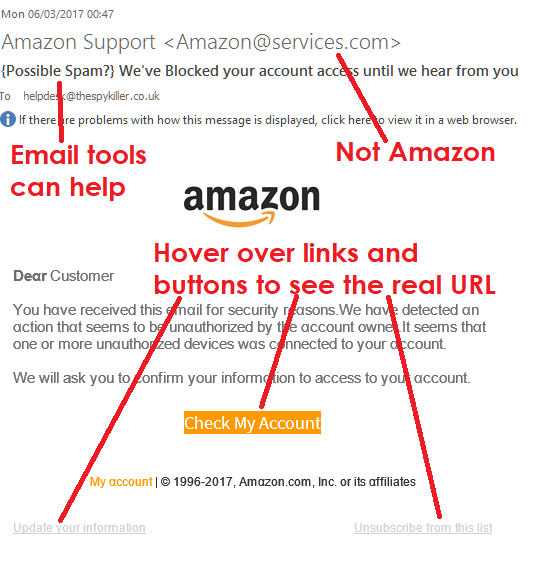Phishing Scam Characteristics And Tips To Avoid Getting Hooked
By: Jim Stickley and Tina Davis
December 28, 2017
Phishing is here to stay. It is at the root of so many scams and that is because it continues to work. Scammers know how to use our love of the Internet against us and they do and use that to steal millions of dollars from us every year. The good news is that even though phishing attacks are getting more creative and more difficult to detect, there are also some repeat offenders that you can watch for and know they are phishing for your sensitive information.
 Disabled or suspended accounts
Disabled or suspended accounts
This type of scam has been spotted purporting to be from various well-known organizations such as Amazon or Apple. An email arrives saying your account has been suspended or deactivated until you login to your account and verify or update your account details. Usually they want payment card information, but also on offer in these scams are login credentials.
Update account information immediately
Netflix was recently used for this type of scam. An email was sent around claiming that an update was needed, and users were to click an included link. This is limited to Netflix, but has also been used to target customers of Apple, Amazon, eBay, FedEx, and other companies.
Online retailer scams
These ramp up during busy shopping seasons. Amazon and eBay are often used as the bait for these, but other online retailers are just as likely to show up. A recent one claims a purchase was made on your account, which is intended to make you fearful that someone has stolen your details. The hope is that you will quickly react and click a link that leads to you to hand over your details to the scammers.
Tax Fraud and Phishing
This type of phishing may not be the most common, but it can be serious. This ruse is particularly true after a large data breach where social security numbers are stolen. Recently, the credit bureau Equifax unintentionally handed over social security and credit information of 147 million U.S. residents to scammers. This little tidbit of top story news is great material for scammers. They send email messages or texts claiming you need to update your tax information in some way due to a massive data breach. They are hoping you’ll click a link or attachment that sends your details to them.
 Quick Tips to Avoid Being Hooked:
Quick Tips to Avoid Being Hooked:
- Stop. Take a moment to consider the sender and the request. If there is a sense of urgency that some “awful” event will happen if you don’t react immediately, it’s very possibly, if not probably phishing. Nothing sent in email is so urgent that you can’t take a moment to consider it before acting.
- Any time you need to update an account or check on your purchases, go directly into your account and check it that way. Don’t click a link or attachment sent in email. Check all your accounts by logging into your account using a bookmarked link or by carefully typing the URL into the browser address bar.
- Remember that the IRS still uses the U.S. Postal Service to initiate correspondence. If you get an unsolicited email or text message from the agency, it’s most likely phishing; especially if it has an included link or attachment.
- If you are suspicious of any link or attachment, regardless of whether it’s a document, spreadsheet, text file or any other file type you receive in email or by text message, pick up the phone and call the sender to verify it before clicking it.
Keeping these few tips in mind will help you avoid becoming a victim of phishing and/or identity theft.